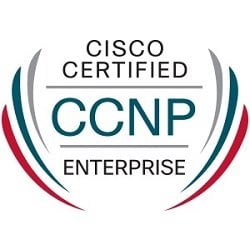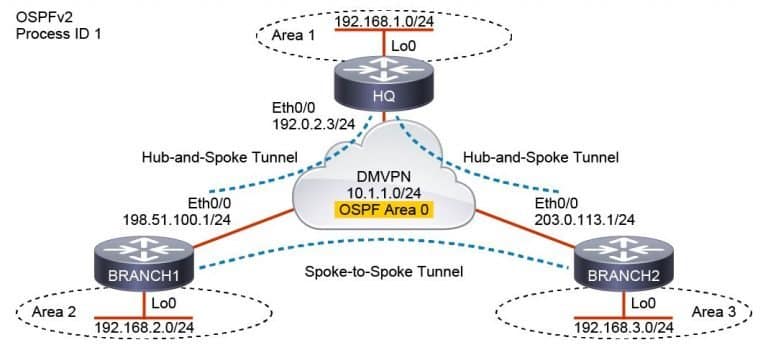Obiettivi | Certificazione | Contenuti | Tipologia | Prerequisiti | Durata e Frequenza | Docenti | Modalità di Iscrizione | Calendario

Il Corso ENARSI Implementing Cisco Enterprise Advanced Routing and Services è parte del percorso Cisco CCNP Enterprise. Il corso si concentra sulla configurazione e l’ottimizzazione delle tecnologie avanzate di routing e servizi in ambienti di rete Cisco Enterprise. Gli obiettivi del corso ENARSI includono la comprensione e l’implementazione di protocolli di routing avanzati come OSPF, EIGRP e BGP, la configurazione e l’ottimizzazione di servizi di rete come QoS, multicast, VPN e DMVPN, l’implementazione di soluzioni di sicurezza avanzate come accesso basato sul ruolo e Cisco TrustSec, la progettazione e l’implementazione di reti IPv6 e la migrazione da IPv4 a IPv6, la risoluzione dei problemi e l’ottimizzazione delle prestazioni delle reti Cisco Enterprise utilizzando strumenti di monitoraggio e analisi, la comprensione delle tecnologie di automazione e programmabilità come Cisco DNA Center e l’automazione con Python e, infine, l’integrazione e la configurazione di soluzioni di infrastruttura wireless avanzate. Il Corso contribuisce alla preparazione dell’esame di Certificazione CCNP Enterprise (Esame 300-410).
Contattaci ora per ricevere tutti i dettagli e per richiedere, senza alcun impegno, di parlare direttamente con uno dei nostri Docenti (Clicca qui)
oppure chiamaci subito al nostro Numero Verde (800-177596)
Obiettivi del corso
Di seguito una sintesi degli obiettivi principali del corso ENARSI Implementing Cisco Enterprise Advanced Routing and Services:
- Comprensione e implementazione di protocolli di routing avanzati come OSPF, EIGRP e BGP.
- Configurazione e ottimizzazione di servizi di rete come QoS, multicast, VPN e DMVPN.
- Implementazione di soluzioni di sicurezza avanzate come accesso basato sul ruolo e Cisco TrustSec.
- Progettazione e implementazione di reti IPv6 e migrazione da IPv4 a IPv6.
- Comprensione delle tecnologie di automazione e programmabilità come Cisco DNA Center e automazione con Python.
Certificazione del corso
Esame 300-410 ENARSI Implementing Cisco Enterprise Advanced Routing and Services;
Esame Parte della Certificazione CCNP Enterprise; Il programma di certificazione CCNP Enterprise prepara per i ruoli professionali nelle più moderne tecnologie nell’ambito dell’Enterprise networking. La CCNP Enterprise ora include elementi di automazione e programmabilità per la massima scalabilità delle moderne infrastrutture di rete. Successore della Certificazione CCNP Routing and Switching, una delle certificazioni più autorevoli del settore. In particolare l’esame 300-410 ENARSI si concentra in modo significativo sulle tecnologie di Layer 3. Qui, i candidati devono dimostrare competenze nel troubleshooting di distanza amministrativa, route map per vari protocolli di routing, meccanismi di prevenzione di loop, redistribuzione tra protocolli di routing, sommarizzazione manuale e automatica, e configurare e verificare il routing basato su policy. Importanti sono anche la comprensione del VRF-Lite e la descrizione del Bidirectional Forwarding Detection. Un’altra area chiave è rappresentata dalle VPN Technologies. I candidati devono essere a conoscenza delle operazioni MPLS, descrivere le VPN Layer 3 MPLS e configurare e verificare DMVPN (Dynamic Multipoint VPN). La sicurezza dell’infrastruttura è altrettanto importante. Il candidato deve essere in grado di eseguire il troubleshooting della sicurezza dei dispositivi utilizzando IOS AAA, comprendere le caratteristiche di sicurezza del router e descrivere le funzionalità di sicurezza First Hop di IPv6. Infine, l’esame copre i servizi di infrastruttura. Questo include il troubleshooting della gestione dei dispositivi, SNMP, problemi di rete utilizzando logging e DHCP per IPv4 e IPv6, oltre a problemi di performance della rete usando IP SLA e NetFlow, e l’uso di Cisco DNA Center per l’assicurazione di rete.
Contenuti del corso
- Implementing EIGRP
- Optimizing EIGRP
- Troubleshooting EIGRP
- Implementing OSPF
- Optimizing OSPF
- Troubleshooting OSPF
- Implementing Internal Border Gateway Protocol (IBGP)
- Optimizing BGP
- Implementing MP-BGP
- Troubleshooting BGP
- Configuring Redistribution
- Troubleshooting Redistribution
- Implementing Path Control
- Exploring MPLS
- Introducing MPLS L3 VPN Architecture
- Introducing MPLS L3 VPN Routing
- Configuring Virtual Routing and Forwarding (VRF)-Lite
- Implementing DMVPN
- Implementing DHCP
- Troubleshooting DHCP
- Introducing IPv6 First Hop Security
- Securing Cisco Routers
- Troubleshooting Infrastructure Security and Services
Attività Laboratoriali
- Configure EIGRP Using Classic Mode and Named Mode for IPv4 and IPv6
- Verify the EIGRP Topology Table
- Configure EIGRP Stub Routing, Summarization, and Default Routing
- Configure EIGRP Load Balancing and Authentication
- LAB: Troubleshoot EIGRP Issues
- Configure OSPFv3 for IPv4 and IPv6
- Verify the Link-State Database
- Configure OSPF Stub Areas and Summarization
- Configure OSPF Authentication
- Troubleshoot OSPF
- Implement Routing Protocol Redistribution
- Manipulate Redistribution
- Manipulate Redistribution Using Route Maps
- Troubleshoot Redistribution Issues
- Implement PBR
- Configure IBGP and External Border Gateway Protocol (EBGP)
- Implement BGP Path Selection
- Configure BGP Advanced Features
- Configure BGP Route Reflectors
- Configure MP-BGP for IPv4 and IPv6
- Troubleshoot BGP Issues
- Implement PBR
- Configure Routing with VRF-Lite
- Implement Cisco IOS DMVPN
- Obtain IPv6 Addresses Dynamically
- Troubleshoot DHCPv4 and DHCPv6 Issues
- Troubleshoot IPv4 and IPv6 Access Control List (ACL) Issues
- Configure and Verify Control Plane Policing
- Configure and Verify Unicast Reverse Path Forwarding (uRPF)
- Troubleshoot Network Management Protocol Issues: Lab 1
- Troubleshoot Network Management Protocol Issues: Lab 2
Tipologia
Corso di Formazione con Docente
Docenti
I docenti sono Istruttori accreditati CISCO e certificati in altre tecnologie IT, con anni di esperienza pratica nel settore e nella Formazione.
Infrastruttura laboratoriale
Per tutte le tipologie di erogazione, il Corsista può accedere alle attrezzature e ai sistemi reali Cisco presenti nei Nostri laboratori o direttamente presso i data center Cisco in modalità remota h24. Ogni partecipante dispone di un accesso per implementare le varie configurazioni avendo così un riscontro pratico e immediato della teoria affrontata. Ecco di seguito alcune topologie di rete dei Laboratori Cisco Disponibili:

Dettagli del corso
Prerequisiti
Si consiglia la partecipazione al Corso Cisco CCNA nonché la partecipazione al corso Cisco CCNP Enterprise ENCOR.
Durata del corso
- Durata Estensiva 60 Ore;
- Durata Intensiva 5gg;
Frequenza
Varie tipologie di Frequenza Estensiva ed Intensiva.
Date del corso
- Corso Cisco ENARSI (Formula Estensiva Serale) – 16/09/2024 – Lun. Mer. Ven. 18:30/21:30
- Corso Cisco ENARSI (Formula Intensiva) – 02/12/2024 – 09:00 – 17:00
Modalità di iscrizione
Le iscrizioni sono a numero chiuso per garantire ai tutti i partecipanti un servizio eccellente.
L’iscrizione avviene richiedendo di essere contattati dal seguente Link, o contattando la sede al numero verde 800-177596 o inviando una richiesta all’email [email protected].


